This is a list of bridges in Poland.
This is a list of bridges in Poland.
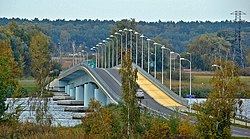

This is a list of notable bridges in Poland. This list sorted by length of the main span.
(*) – Planned bridge
^^ – Under construction bridge

Kraków is the second-largest and one of the oldest cities in Poland. Situated on the Vistula River in Lesser Poland Voivodeship, the city dates back to the seventh century. Kraków was the official capital of Poland until 1596 and has traditionally been one of the leading centres of Polish academic, economic, cultural and artistic life. Cited as one of Europe's most beautiful cities, its Old Town with Wawel Royal Castle was declared a UNESCO World Heritage Site in 1978, one of the world's first sites granted the status.

Lesser Poland, often known by its Polish name Małopolska, is a historical region situated in southern and south-eastern Poland. Its capital and largest city is Kraków. Throughout centuries, Lesser Poland developed a separate culture featuring diverse architecture, folk costumes, dances, cuisine, traditions and a rare Lesser Polish dialect. The region is rich in historical landmarks, monuments, castles, natural scenery and UNESCO World Heritage Sites.
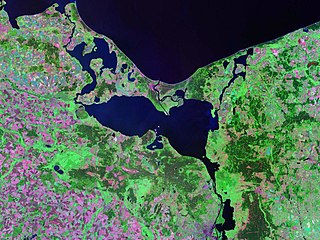
Wolin is a Polish island in the Baltic Sea, just off the Polish coast. Administratively, the island belongs to the West Pomeranian Voivodeship. Wolin is separated from the island of Usedom (Uznam) by the Strait of Świna, and from mainland Pomerania by the Strait of Dziwna. The island has an area of 265 km2 (102 sq mi) and its highest point is Mount Grzywacz at 116 m above sea level. The number of inhabitants is 30,000. Eastern suburbs of the city of Świnoujście extend to the Wolin island, while the towns of Międzyzdroje and Wolin lie further east.

Kraków John Paul II International Airport is an international airport located near Kraków, in the village of Balice, 11 km (6.8 mi) west of the city centre, in southern Poland. It is the second busiest airport of the country in terms of the volume of passengers served annually. The airport is named after Pope John Paul II.

Łowicz is a town in central Poland with 27,436 inhabitants (2021). It is situated in the Łódź Voivodeship ; previously, it was in Skierniewice Voivodeship (1975–1998). Together with a nearby station of Bednary, Łowicz is a major rail junction of central Poland, where the line from Warsaw splits into two directions - towards Poznań, and Łódź. Also, the station Łowicz Main is connected through a secondary-importance line with Skierniewice.

Wadowice is a town in southern Poland, 50 kilometres southwest of Kraków with 17,455 inhabitants (2022), situated on the Skawa river, confluence of Vistula, in the eastern part of Silesian Foothills. Wadowice is known for being the birthplace of Karol Wojtyła, later Pope John Paul II and Godwin von Brumowski, Austria-Hungary’s best flying ace with 35 credited and an additional 8 possible wins in the air.
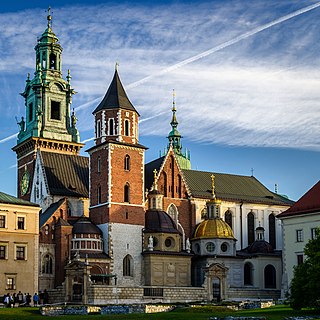
The Wawel Cathedral, formally titled the Royal Archcathedral Basilica of Saints Stanislaus and Wenceslaus, is a Roman Catholic cathedral situated on Wawel Hill in Kraków, Poland. Nearly 1000 years old, it is part of the Wawel Castle Complex and is a national sanctuary which served as the coronation site of Polish monarchs.

The Emperor Ferdinand Northern Railway was a railway company during the time of the Austrian Empire. Its main line was intended to connect Vienna with the salt mines in Bochnia near Kraków. The name is still used today in referring to a number of railway lines formerly operated by that company.

An extradosed bridge employs a structure that combines the main elements of both a prestressed box girder bridge and a cable-stayed bridge. The name comes from the word extrados, the exterior or upper curve of an arch, and refers to how the "stay cables" on an extradosed bridge are not considered as such in the design, but are instead treated as external prestressing tendons deviating upward from the deck. In this concept, they remain part of the main bridge superstructure.

The Pontifical University of John Paul II is an academic institution located in Kraków, Poland, that offers graduate degrees in theology, philosophy, and church history. It derived from the theology faculty of Jagiellonian University established in 1397. The theology faculty was expelled from the university by Communist authorities in 1954. Remaining under the supervision of the Vatican, the faculty received the honorific title of "Pontifical" in 1974 and was established as an Academy of Theology by Pope John Paul II in 1981 before becoming the Pontifical University of John Paul II in 2009.

Tarnovia Tarnów is a Polish sports club, founded in 1909 in the southern city of Tarnów. With white and red hues, the club's founders wanted to emphasize their patriotism, during the time when their homeland was divided into three powers. Tarnovia was based on two smaller teams, which had been created by students of local high schools in 1906 and 1908. These organizations, called Bialo-Czerwoni and Pogon, merged in 1909, creating Tarnovia. In the interbellum period its soccer team played in Kraków's A-Class.

Louis-Christophe Zaleski-Zamenhof was a Polish-born French civil and marine engineer, specializing in the design of structural steel and concrete construction. He was a grandson of the Polish Jewish L. L. Zamenhof, the inventor of the international auxiliary language Esperanto. From the 1960s until his death, Zaleski-Zamenhof lived in France.

The architecture of Poland includes modern and historical monuments of architectural and historical importance.
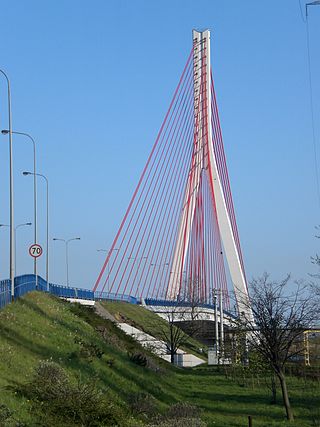
The Third Millennium John Paul II Bridge is a cable-stayed road bridge which spans the Martwa Wisła River in Gdańsk, Poland.
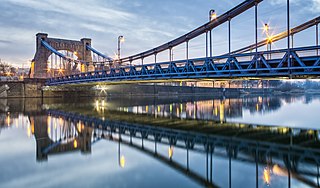
Grunwald Bridge is a suspension bridge over the river Oder in Wrocław, Poland, built between 1908 and 1910. Initially the bridge was called the Imperial Bridge (Kaiserbrücke), then the Bridge of Freedom (Freiheitsbrücke). The architectural design of the bridge was by a city councilor, Richard Plüddemann. The bridge opened on 10 October 1910 in the presence of Emperor Wilhelm II.

The Bishop's Palace in Kraków is the seat of Kraków metropolitan Curia, Poland, and the traditional residence of Kraków bishops since the late 14th century. It is the second largest palace in the city after Wawel, former seat of the Polish monarchs. It is part of a monastery complex of the Franciscan religious order. Bishop's Palace is best known for being the residence of Pope John Paul II during his stays in the city. He used to give his blessings and talk to his followers from a window above the main entrance at night.

Arrah–Chhapra Bridge is the longest multi-span extradosed bridge in the world with a main bridge length of 1,920 m (6,300 ft). The bridge crosses over the Ganges River in India, connecting Arrah in Bhojpur district to Chhapra in Saran district of Bihar state. The bridge provides a roadway link between the northern and southern parts of Bihar. The bridge opened for public use on 11 June 2017.
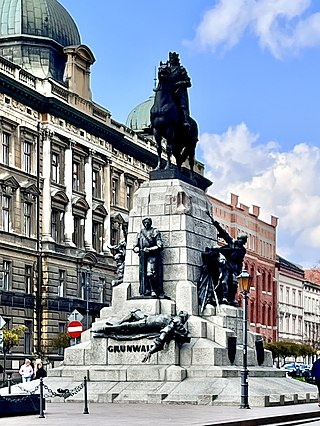
The Grunwald Monument is an equestrian statue of King of Poland Władysław II Jagiełło (1352–1434) located at Matejko Square in Kraków's Old Town and constructed in 1910 to commemorate the 500th anniversary of the Battle of Grunwald. The statue depicts Jagiełło atop his horse with his cousin, and Grand Duke of Lithuania, Vytautas to his front. On either side of Jagiełło are soldiers lifting their arms in celebration of victory. Depicted lying dead at the steps of the statue is Grand Master of the Teutonic Knights Ulrich von Jungingen. It was destroyed in 1939 by Nazi Germans and reconstructed in 1976 according to project by Marian Konieczny.
Mieczysław Wawrzusiak was a former Polish footballer who played as a midfielder.